Green Discourse in the Wihelmina Cullen Admissions Center
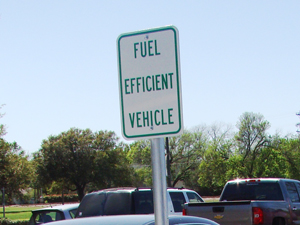
Green Discourse in the Wihelmina Cullen Admissions Center

The Wilhelmina Cullen Admissions Center (WCAC) was designed to meet the U.S. Green Building Council's LEED (Leadership in Energy and Environmental Design) standards, featuring a bamboo floor, locally manufactured building materials and waterless urinals among other green initiatives. As I discuss in the Overview, the Wilhelmina Cullen Admissions Center performs Southwestern for prospective students and parents. Uses of environmentally conscious or green spaces play a major role in this performance. Through the WCAC's heavy focus and organization around green functions (eg. the "Fuel Efficient Vehicle" parking spaces, the pamphlets and fliers, and especially the architecture), they are instituting a "way of seeing" (Rose, 2006) Southwestern as green. In this page, I critically analyze green discourses in the WCAC and apply that analysis to larger themes in the building.
As the news story I brought up in the introduction states, the WCAC is a "facility that better exemplifies the university." It is strange to say however, that this "Green by Design" building is exemplary of the university, when it is the first and only building with such strong green initiatives. My argument about the building, however, does not create a contradiction here. While Southwestern's other buildings were constructed before the green movement took off, the rest of the campus is very green conscious with recycling bins in every dorm room, "Conserve" stickers on most light switches, and the cafeteria's recent initiative to replace Styrofoam with a more environmentally friendly material for to-go food. These things, like Pirate Bikes are participatory and hard to show to prospective students and parents. Instead, the WCAC's construction is exemplary of Southwestern's green mentality. It is also, however, an "institutional apparatus," "at once an architectural design and a moral and philosophical treatise" (Rose, 2006, p. 174). The WCAC is at the same time a building and an apparatus that rhetorically induces visitors to read Southwestern as environmentally friendly.
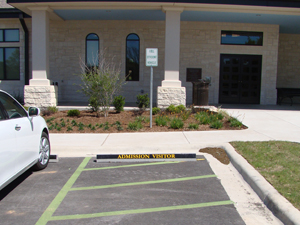
| The green discourse begins in the parking lot. Directly outside the building, there are two parking spots opposite each other with signs that read "Fuel Efficient Vehicle" in green text. They are one of the WCAC's "institutional technologies" (Rose, 2006, p. 174), an element of the space that reinforces the concept of Southwestern as environmentally conscious. The ground of the parking spot itself has diagonal stripes of green paint across it. As if a sign marking priority parking for fuel-efficient vehicles is not explicitly environmentally conscious enough, they must use green text and green paint to reiterate and reinforce this idea. These fuel-efficient vehicle parking spots were constructed with the WCAC and are the only two featured on campus. To prospective students and parents, however, this is part of their very first interaction with Southwestern. |
| Upon entering the WCAC, one of the first things you see is the frosted glass panel that outlines the WCAC's LEED certifications. It is in the entryway, with the 'admission center' Pirate Bike placed directly under it. The LEED certification plaque has no actual environmentally positive function, but rather is there to show that the WCAC, and therefore Southwestern, is performing an environmentally-conscious function. In semiotic terms, it is a signifier. It signifies first that the WCAC meets LEED standards, and second, that Southwestern as a whole subscribes to these values. A value that, as the news article says, "should appeal to prospective students." |
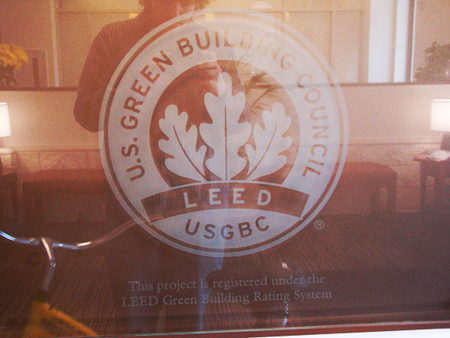
|
It is interesting that within the building, so many of the green aspects are invisible that they are constantly compelled to explicitly point out the green features of the building. Take the news article again for example:
| Features that make the building "green" include a bamboo floor in the lobby area, skylights in the center of the building, waterless urinals, solar-powered sink faucets and reflective roof shingles. At least 20 percent of the materials used in the building were extracted and manufactured within 500 miles of the project site. All paints, finishes, adhesives and sealants used on the interior of the building had low VOC content. The building also is surrounded by landscaping that uses native plants. |
Few of these elements are visually available. Being a rhetorical space, however, it is only expected that they would want to showcase these things. The title of the news article is even "New Admission Building Opens, Wilhelmina Cullen Admission Center is Southwestern's first 'green' building." This reflects "postmodern architecture's contextualism--its sensitivity to its environment and users" (Blair, 1991, p. 269). Clearly, the WCAC was designed in context to what they knew their audience wants. Environmentalism has grown in popularity over the last several years, particularly in the local metropolitan area of Austin, and the WCAC is playing into that growth in popularity.
| This sensitivity to environmental issues even extends to the pamphlets and bags the WCAC gives out. When I was visiting the building for research, one of the people working there gave me a handout and a bag that they give to visiting students. The handout is printed on a thick and heavy paper, almost like card stock. The front image is what looks like a concept drawing of the WCAC, with the caption "Designed to meet certification standards set by the U.S. Green Building Council for Leadership in Energy and Environmental Design." A note on the back informs me that it is printed on recycled paper. |
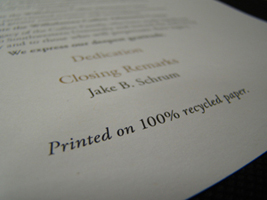
|
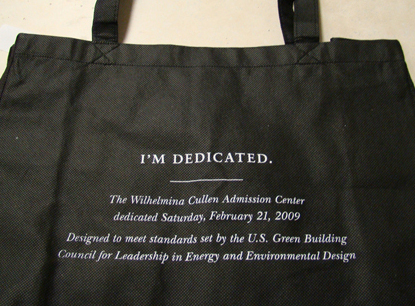
| The bag carries a similar sentiment, but carried a number of deeper meanings. The front of the bag simply says "Southwestern." As you can see here, the back of the bag says, "I'm dedicated" and follows with the same quote from the handout. It is ambiguous whether it is Southwestern as an institution or the bag's carrier who is dedicated. Also, while the next line gives details about the dedication of the WCAC, it is still ambiguous as to who the "I'm" references what it is dedicated to. |
| Also important here is the materiality of the bag. When it was first handed to me, I thought that it was a shopping bag such as the reusable ones that you can buy in grocery stores. While I'm still unsure of the intended purpose of the bags, I immediately conjured up comparisons between this bag and the reusable shopping bags you can buy in stores. It even has the same woven plastic texture I tried to photograph here. |
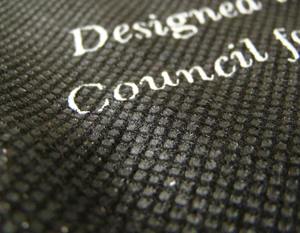
|
Although the individual elements of the parking spaces, news story and pamphlets might seem insignificant, taken together they create an identity of Southwestern as an environmentally-conscious university. At the same time, Southwestern is playing into the larger environmentalist movement and attaching itself to that movement through the WCAC.
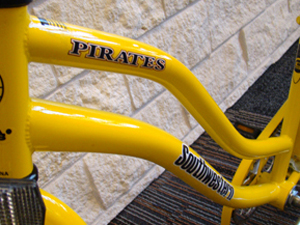
|
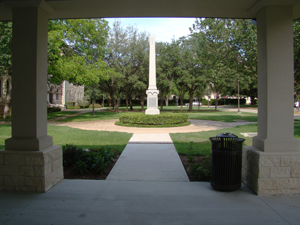
| |
Recontextualizing and Making Meaning
| Progressive Traditions in the WCAC |
Progressive Traditions in the WCAC: Home | Introduction | Pirate Bikes | Green Discourse | Progressive Traditions